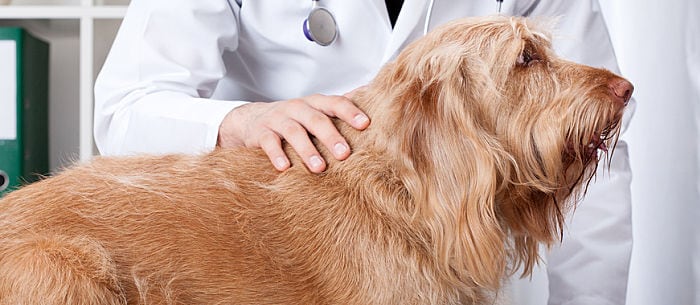It’s hard to keep track of everything that could harm your beloved dog. Even when something is uncommon and almost unheard of, like sarcoma in dogs, you like to be your dog’s first line of defense. Sarcoma in dogs is a cancerous, malignant tumor or growth that can appear on the skin or inside the dog. It only occurs in 35 out of 100,000 dogs, according to the National Canine Cancer Foundation (NCCF), but the more you know about this disease, the more likely you are to catch it early.
According to the Sarcoma Alliance, approximately 15 percent of skin lumps in dogs are sarcomas. “There is no ‘typical prognosis’ when it comes to sarcoma. Any thoughtful prognosis will have to take into account the type of sarcoma, how early it’s detected, the treatment administered and what the grade (how advanced) of the sarcoma is,” says veterinarian Dr. Jeff Werber of Century Veterinary Group.
Two common types are:
- Hemangiosarcoma
According to the NCCF, this type is a cancer of blood cells that often causes small blood-filled tumors that rupture unexpectedly, causing a potentially life-threatening bleed. It’s most common in larger breeds like German shepherds.
- Osteosarcoma
An aggressive sarcoma of the bones that can easily spread to other parts of the body, osteosarcoma in dogs is also common in larger breeds, according to the NCCF.
By the time sarcomas are detected, sometimes they’ve spread through the lymph system and affected other organs — namely the liver and lungs. No matter what your pet’s prognosis is, your vet can always help.
“Is there any ‘solution’ or treatment for sarcoma in dogs? Yes. There is no cure for cancer, but the first line of treatment for sarcomas is surgery to achieve ‘clean margins,'” says Dr. Lori Pasternak, a veterinarian at Helping Hands Affordable Veterinary Surgery & Dental Care. “If the tumor is graded as high grade or removal is incomplete then adjunctive therapy such as chemotherapy is indicated. Chemotherapy is well tolerated in dogs.”
Dr. Werber and Dr. Pasternak advise pet parents to watch for these symptoms:
- Enlarged Lymph Nodes
Check around the neck, the underarm and back legs.
- Bloated Belly
Pale gums and loss of energy could accompany this.
- Leg Issues
Limping, change in gait, pain or swelling of the legs can occur, especially if one leg is larger than the other.
- Unusual Growths
Any unusual growths or swelling are a common sign of trouble.
- Sudden Developments
Rapid changes in your dog’s health or behavior should get checked out.
- Weight Changes
Sudden weight loss or increased thirst can’t be taken lightly.
Karen Q. from Massachusetts, who preferred her last name and town not be named, noticed a few lethargic spells and loss of appetite in her beloved Vizsla, Cooper, but he bounced back after a few hours. “Cooper suddenly became lethargic again and this time his gums became white. Our vet said to rush him to the emergency vet and an ultrasound revealed tumors bursting on his spleen.” His spleen was removed but Cooper was diagnosed with hemangiosarcoma, and eventually succumbed to his disease.
Dr. Werber urges his clients to get to know their pet’s “normal.” You have a better chance of knowing when things begin to go awry. Notice how pink your dog’s gums are, pet your dog daily and pay attention to any lumps, bumps or growths. If you take your dog to the groomer, have them feel for lumps and abnormalities, too. Also take note of appetite and energy levels, so you can catch abnormalities.
Cheryl Caira from Framingham, Massachusetts has a black lab named Kimmie, whom they took to the vet when they thought she had a bug bite that just wouldn’t go away. It was sarcoma. “When the doctor removed the tumor, he took the margins around the tumor which saved her life,” Caira explains.
Caira implores dog owners to go to the vet if they sense something isn’t healing or isn’t right. “The earlier you get them checked and something done, the better prognosis you might have,” she says. No matter how scary it sounds, a rare tumor can never take away what your pet has already given, and will give, you. As Dr. Weber says, “We can still maximize quality of life and, since dogs are so great at living ‘in the moment,’ continue to make meaningful memories that we’ll cherish all of our lifetime.”
And read 5 Reasons a Dog Cyst Isn’t Cancer.
Laura Richards is a Boston-based freelance writer and the mother of four boys including a set of identical twins and also mom to three rescue pets: Scarlett, a 7-year-old beagle, and Edith and Ollie, 15-year-old identical twin black cats. She has written for numerous parenting publications and is the president of On Point Communications.
* This article is for general informational purposes only. It is not intended nor implied to be providing medical advice and is not a substitute for such advice. The reader should always consult a health care provider concerning any medical condition or treatment plan. Neither Care.com nor the author assumes any responsibility or liability with respect to use of any information contained herein.

